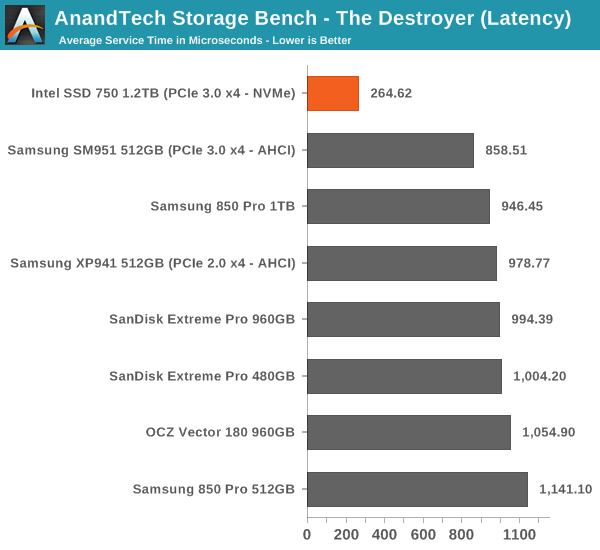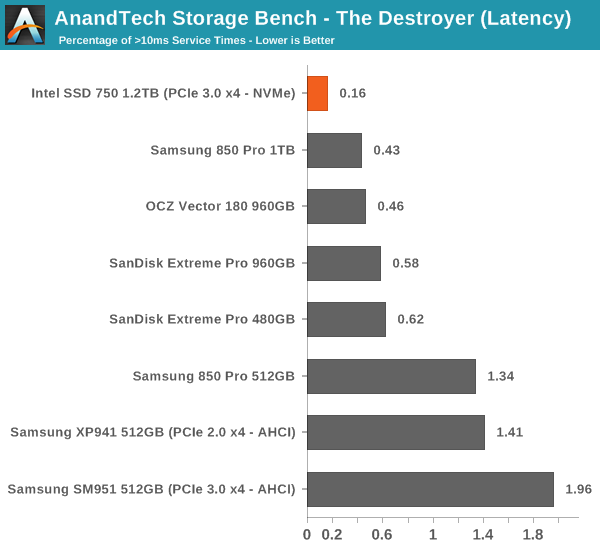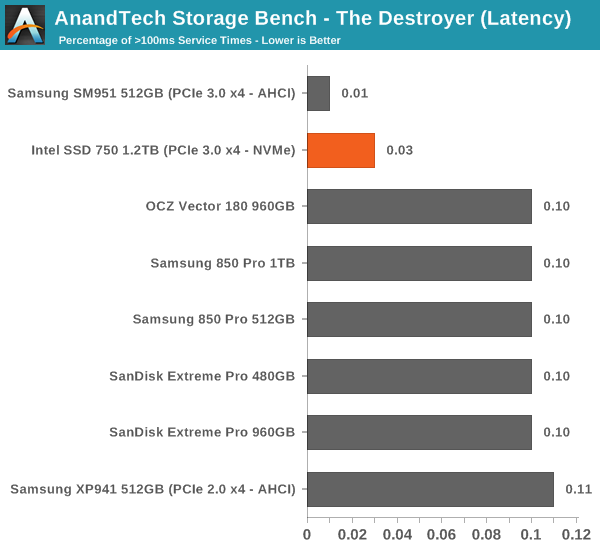Intel SSD 750 PCIe SSD Review: NVMe for the Client
by Kristian Vättö on April 2, 2015 12:00 PM ESTAnandTech Storage Bench - The Destroyer
The Destroyer has been an essential part of our SSD test suite for nearly two years now. It was crafted to provide a benchmark for very IO intensive workloads, which is where you most often notice the difference between drives. It's not necessarily the most relevant test to an average user, but for anyone with a heavier IO workload The Destroyer should do a good job at characterizing performance.
| AnandTech Storage Bench - The Destroyer | ||||||||||||
| Workload | Description | Applications Used | ||||||||||
| Photo Sync/Editing | Import images, edit, export | Adobe Photoshop CS6, Adobe Lightroom 4, Dropbox | ||||||||||
| Gaming | Download/install games, play games | Steam, Deus Ex, Skyrim, Starcraft 2, BioShock Infinite | ||||||||||
| Virtualization | Run/manage VM, use general apps inside VM | VirtualBox | ||||||||||
| General Productivity | Browse the web, manage local email, copy files, encrypt/decrypt files, backup system, download content, virus/malware scan | Chrome, IE10, Outlook, Windows 8, AxCrypt, uTorrent, AdAware | ||||||||||
| Video Playback | Copy and watch movies | Windows 8 | ||||||||||
| Application Development | Compile projects, check out code, download code samples | Visual Studio 2012 | ||||||||||
The table above describes the workloads of The Destroyer in a bit more detail. Most of the workloads are run independently in the trace, but obviously there are various operations (such as backups) in the background.
| AnandTech Storage Bench - The Destroyer - Specs | ||||||||||||
| Reads | 38.83 million | |||||||||||
| Writes | 10.98 million | |||||||||||
| Total IO Operations | 49.8 million | |||||||||||
| Total GB Read | 1583.02 GB | |||||||||||
| Total GB Written | 875.62 GB | |||||||||||
| Average Queue Depth | ~5.5 | |||||||||||
| Focus | Worst case multitasking, IO consistency | |||||||||||
The name Destroyer comes from the sheer fact that the trace contains nearly 50 million IO operations. That's enough IO operations to effectively put the drive into steady-state and give an idea of the performance in worst case multitasking scenarios. About 67% of the IOs are sequential in nature with the rest ranging from pseudo-random to fully random.
| AnandTech Storage Bench - The Destroyer - IO Breakdown | |||||||||||
| IO Size | <4KB | 4KB | 8KB | 16KB | 32KB | 64KB | 128KB | ||||
| % of Total | 6.0% | 26.2% | 3.1% | 2.4% | 1.7% | 38.4% | 18.0% | ||||
I've included a breakdown of the IOs in the table above, which accounts for 95.8% of total IOs in the trace. The leftover IO sizes are relatively rare in between sizes that don't have a significant (>1%) share on their own. Over a half of the transfers are large IOs with one fourth being 4KB in size.
| AnandTech Storage Bench - The Destroyer - QD Breakdown | ||||||||||||
| Queue Depth | 1 | 2 | 3 | 4-5 | 6-10 | 11-20 | 21-32 | >32 | ||||
| % of Total | 50.0% | 21.9% | 4.1% | 5.7% | 8.8% | 6.0% | 2.1% | 1.4% | ||||
Despite the average queue depth of 5.5, a half of the IOs happen at queue depth of one and scenarios where the queue depths is higher than 10 are rather infrequent.
The two key metrics I'm reporting haven't changed and I'll continue to report both data rate and latency because the two have slightly different focuses. Data rate measures the speed of the data transfer, so it emphasizes large IOs that simply account for a much larger share when looking at the total amount of data. Latency, on the other hand, ignores the IO size, so all IOs are given the same weight in the calculation. Both metrics are useful, although in terms of system responsiveness I think the latency is more critical. As a result, I'm also reporting two new stats that provide us a very good insight to high latency IOs by reporting the share of >10ms and >100ms IOs as a percentage of the total.

In terms of throughput, the SSD 750 is actually marginally slower than the SM951, although when you look at latency the SD 750 wins by a large margin. The difference in these scores is explained by Intel's focus on random performance as Intel specifically optimized the firmware for high random IO performance, which does have some impact on the sequential performance. As I've explained above, data rate has more emphasis on large IO size transfers, whereas latency treats all IOs the same regardless of their size.

The number of high latency IOs is also excellent and in fact the best we have tested. The SSD 750 is without a doubt a very consistent drive.












132 Comments
View All Comments
mmrezaie - Thursday, April 2, 2015 - link
finally it has started, although I wont budge now. maybe next generation.blanarahul - Thursday, April 2, 2015 - link
Hey Kristian, I read that the 1.2 TB model uses 84 dies. But that's not a multiple of 18. So what gives? Is it running in 14 channel mode or something?blanarahul - Thursday, April 2, 2015 - link
Okay so it has 86 dies. But now it's even more confusing. Aren't they supposed be multiples of number of channels the controller is using?SunLord - Thursday, April 2, 2015 - link
Its likely 18 channels so 4 probably only address 4 dies while the 14 other channels handle 5woggs - Thursday, April 2, 2015 - link
yepTyrDonar - Friday, April 10, 2015 - link
Controllers don't have to operate on a specific multiple of the number of dies. That's just a coincidence as to how we've seen them so far on most SSD's. They can operate with varying priorities and asymmetrically. Further, more than 1 channel can address the same die in different intervals/priorities. As controllers become more and more complex, this kind of assymetrical operation will become more common, unfortunately this is correlated with increasing number of total dies and lower reliability.huaxshin - Thursday, April 2, 2015 - link
Will there be any M2 SSDs from Intel with NVMe? Some notebooks, and desktops, have routed PCIe to M2 slots where its the only place its available.blanarahul - Thursday, April 2, 2015 - link
No.DigitalFreak - Thursday, April 2, 2015 - link
Not with this controller. Maybe down the road.bgelfand - Thursday, April 2, 2015 - link
I suspect this drive is not for the current z97 chip set, but will realize its potential with the Z170 chipset (Sunrise Point) due for release in the second half of this year with Skylake. The Z170 chipset has 20 PCIe 3.0 lanes and DMI 3.0 (8 GB/s) bus interface.It should be a very interesting second half of the year - Skylake CPU, Sunrise Point chipsets, and Windows 10.